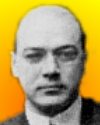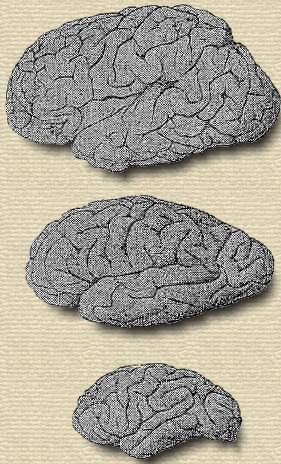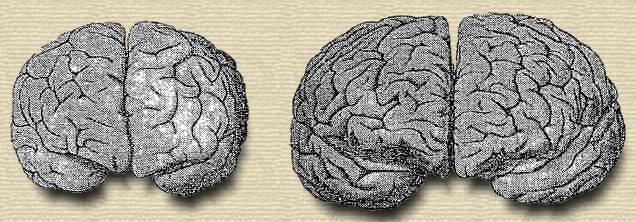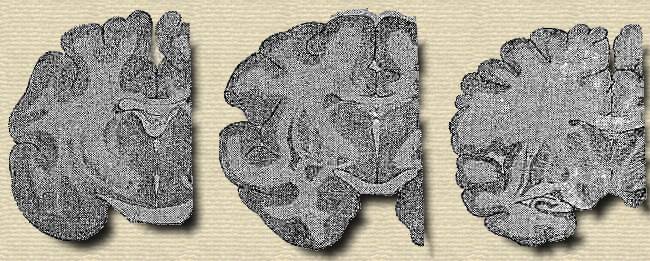 (source)
(source)
|
Edward Anthony Spitzka
(17 Jun 1876 - 4 Sep 1922)
American anatomist and brain morphologist.
|
Looking for "The Face Within the Face" in Man
Article from New York Times (1906)

(Top down) Brain of Helmholtz (After Photo of Cast by Hausemann). Brain of Papuan from British New Guinea; Specimen in Anatomical Laboratory at Columbia University (Bottom) Brain of Gorilla (D. 658, Mus. Roy. Coll. Surgeons of England.)
Dr. Spitzka, Surrounded by His Collection of Brains,
Discusses the Latest Phases of Cerebral Science —
No Such Thing as a "Criminal Brain Type," He Says.

“IF you have brains, prepare to shed them now.” If one may paraphrase Mark Antony's famous invocation thus, it would give voice to one of the latest demands that the scientific investigator is making to those who would contribute something to the search for accurate knowledge on a subject of vital importance to humanity. In that spheroidal box of bone, the top of which is adorned, in some instances, with hair, that every man, woman, and child carries above his or her shoulders, there is usually a soft gray and white substance, full of wrinkles and creases, weighing on an average, fifty ounces, called a brain. It is this soft substance that directs the thinking and moving machinery called man - and how it does it, and why it does it well in some cases and badly in others is the problem science would solve. Hence the need for brain specimens to furnish the brain laboratory of the investigator in this curious department of knowledge. Three associations have already been formed for the preservation of brains after death for the benefit of scientific research - the Mutual Autopsy Society of Paris, the American Anthropometric Society, and the Cornell Brain Association. Quite recently, also, the Association of American Anatomists appointed a committee on brain bequests and preservation methods, consisting of Dr. Edward Anthony Spitzka, Prof. Wilder of Cornell University and Dr. Hrdlicka. The object of this committee is to suggest ways for making bequests that will hold in law, and to bring about a uniform method to be used in brain dissection.
On the top floor of a handsome modern dwelling in this city, 66 East Seventy-third Street, is the workshop of one of the recognized leaders in this department of inquiry, Dr. Edward Anthony Spitzka, whose father, Dr. E. C. Spitzka, the noted alienist, living in the same house, is the discover of the inter-optic lobes of the lower brain. To the uninitiated this workshop of the Spitzkas is somewhat forbidding, a medley of charts covered with unintelligible lines and measurements, learned books and pamphlets, death masks, physiological casts, and, the key to much of this mystery, jar upon jar of human brains - brains of murderers, brains of scientists, brains of writers, brains of plain, ordinary people, brains of apes. There are about thirty in all, each in its own jar, swimming in a solution of formalin and salt. At the College of Physicians and Surgeons there are 600 more specimens of the same kind in Dr. Spitzka's care, together with brains of the lower animals. Each brain in the doctor's private study has a record of its life history, an account of what it did, for weal or woe, while it had a body to serve its behests, before it reached its last abode, an inert, pulpy mass, in the formalin jar.
“Yes, there are the brains of some noted criminals in some of those jars,” remarked Dr. Spitzka, in answer to my inquiry, “and. if certain theories as to the ‘criminal brain type’ were correct, it ought to be possible to distinguish the jar that holds the criminal brain from its neighbor that is occupied by the brain of some man of genius. But I have yet to find the scientist who could make such a discrimination. Notwithstanding a notion that in some quarters is rather prevalent, the study of criminals by anthropological methods does not necessarily tend to establish a criminal ‘type’ nor to describe crime as equivalent to infantilism, epilepsy, atavism, genius, or anything else maintained by the Lombroso school. Many criminals show not a single anomaly in their physical or mental make-up, while many persons with marked evidences of structural aberration have never exhibited the. criminal tendency. Every attempt to prove crime to be due to a constitution peculiar only to criminals has failed signally. It is because most criminals are drawn from the ranks of the low, the degraded, the outcast, that investigators were ever deceived into attempting to set up a ‘type’ of criminal. The social conditions which foster the great majority of crimes are more needful or study and improvement; by such means only can crime be made less prevalent – among the sane, at least. Society wrongs neither the criminal nor itself if criminals were studied as individuals and not as a ‘species.’ From the study of known normal brains we have learned that there is a certain range of variation of structural characters. No two brains are exactly alike, and the greatest source of error in the assertions of Benedickt and Lombroso has been the finding of this or that variation in a criminal's brain and maintaining such to be a characteristic of the ‘criminal constitution’ - unmindful of the fact that like variations of structure may and do exist in the brains of normal, moral persons. It were as justifiable to set up a ‘criminal brain type’ as to speak of an ‘insane brain type’; and the classes of criminality are quite as numerous as the kinds of insanity. In criminals demonstrably sane in life I have failed thus far to find any cerebral characteristic ascribable to an alleged ‘criminal constitution.’ Out of the brain specimens of seventeen murderers that I have studied, some of which are in the jars that you see, I have been unable to find one showing anything abnormal, or that could be taken in any way to be corroborative of a criminal brain type.
“Take the case of Czolgosz, for instance, whose brain I examined - although I did not preserve it. So far as our knowledge of the correlation of brain structure and brain function extends, nothing was found in the brain of this assassin that would condone his crime for the reason of mental disease due to intrinsic cerebral defect or distortion. The brain weight, a little over rather than under the average, pointed to a good condition of the organ. The development or the fissures was in the direction usual in ordinary, average brains. Generally speaking, the brain did not exhibit that especial kind of symmetry of structure in the cerebral halves that is so characteristic of the brains of highly endowed individuals; but there were absolutely none of those conditions present that could have been at the bottom of any abnormality or mental derangement. . Hence, in Czoigosz's case, the verdict must be, ‘socially diseased and perverted, but not mentally diseased.’
“If there is error in the ‘criminal type’ theory what is there in the claims of phrenology? you ask. Absolutely nothing. The idea that the bumps or depressions on a man's head indicate the presence or absence of certain moral characteristics in his mental equipment is one of the absurdities developed from studies in this field that has long since been discarded by science. The ideas of the phrenologist Gall, however ridiculous they may now seem in the light of a century's progress, were nevertheless destined to become metamorphosed into the modern principles of cerebral localization. This is now a firmly established doctrine, amplified and systematized by contributions from many sources, and important results should be expected from studies of brains of the various races, sexes, and individuals with marked mental traits. From this study we know that persons possessing great intellectual capacity, persons excelling in the creative arts, the sciences, and in human affairs in general are apt to have heavier, larger brains than those of the ordinary population, as well as brains showing a greater complexity in their convolutions. As you can see in these specimens, the brain surface presents alternating depressions or fissures marking these convolutions. The surface pattern at these fissures and, convolutions shows the same general features in all normal human brains, and, to some extent, in the higher anthropoid apes as well. When we come to make more careful comparisons, however, and delve more deeply into details of the arrangement of these fissures, we recognize many differences, not only in the brains of races and of individuals, but also in the two cerebral halves of the same individual. It is a significant fact, by the way, that we find the higher anthropoids not further removed from the lower races of man with respect to brain weight and structure than are the latter from a number of men or superior intellect in the white race. The jump in this respect from a Cuvier or a Thackeray, for instance, to a Zulu or a Bushman is no less than from the latter to the gorilla or the orang.
“There is a physiognomy of brain which portrays intellectuality quite as often as does the outward physiognomy. That this so-called cerebral physiognomy is difficult to describe in so many words, or that we are occasionally deceived by it, does not alter the fact that we may generally learn to recognize and judge it. Patient study of a greater amount of suitable material may in the future enable us to express in scientific terms what is now a mere personal conviction. In these studies, by the way, one cannot restrain the thought, What a pity that we have not the brain of a Newton, a Shakespeare, a Michael Angelo, a Beethoven, or an Edgar Allan Poe! How much more useful would be the contemplation of such organs of thought, how elevating, how inspiring would their lessons be! Hitherto, however, we have examined, almost exclusively, the brains of pauper ne'er-do-wells and criminals.

(Right) Frontal Aspect of the Brain of George Francis Train. This is in many respects One of the Best Developed Brains on Record.
“One of the best-developed brains on record recently came into my collection, this brain that you see here. To whom did it belong? He was a familiar figure to every old New Yorker, and his name is probably known from here to the Pacific. In weight this brain of his is above the average, and in structural features admirable, in the depth and complexity of the fissures and convolutions with which it is marked. Contrast it with this Papuan brain. Can you not recognize at a glance the intellectual physiognomy in the one, and the lack of it in the other? I think any student, without knowing anything about the man from whom it was taken, would say that this brain belonged to a person of note, of unusual attainments and ability, and he certainly was a remarkable man, even if there may have been some little defect somewhere in his mentality - although his brain shows not a single imperfection to the anatomist. He had an eventful career. Starting out a penniless lad, at the age of 20 he had accumulated an income of $10,000. He introduced the first street railway in Europe. In this country he built the Union Pacific Railroad and opened up navigation and commerce between the United States and the Far East. More than once he got into jail, and in six different courts, without proper trial, he was adjudged a lunatic, although no insanity expert would sign his commitment papers. Just before he died, not much more than a year ago, an old man at the Mills Hotel, he dictated his remarkable autobiography, an amazing record of facts, accurate in detail, admirable in expression - a book of about 100,000 words in length, all of which was dictated in the space of thirty-five hours. Possibly, in some little fibre of this wonderful brain of his, there was what we might call a ‘screw loose,’ though I have been unable to detect it. Did you ever see him on his old bench in Madison Square playing with the children? He was a strange, many-sided character, an encyclopedia of information, and the aspect, the face written, on his brain, complex and highly developed as you see, denotes just about what he was, the eccentric ‘citizen’ George Francis Train.

“In comparing brains, such as this specimen from the head of George Francis Train, with others lower down in the scale of intelligence, besides the differences in weight and structure, you will notice a difference in composition, and in a direction that overturns a popular conception. One often hears it said of an intellectual man, ‘He has lots of gray matter.’ To be sure the statement is true enough, but not in the sense commonly implied. The brain of man is characterized more by its preponderance of white matter over that of gray matter than for its preponderance of gray matter over the gray matter of the lower animals, excluding perhaps the larger whales and the elephants, The value of arriving at a true estimate of the importance of the ratio of white and gray matter has been greatly enhanced by recent researches, and, as a result, it is seen that the preponderance of white over gray matter indicates the higher intelligence.
“An interesting and most important branch of the study of brain anatomy is the comparison of racial brains. In spite of the meagre records in this direction up to the present time, there seems to be little doubt of the existence of typical distinctions between the brains of different races. That such distinguishing features have not yet been definitely established is due entirely to the lack of sufficient specimens. For a while, at least, we must be content to say that there is something in the ‘cerebral physiognomy’ which seems at times quite as expressive, in the brains of the inferiorly equipped races when compared with those of the highly intellectual as the dull, stupid, vacuous, outer physiognomy of the half-witted individual differs from the bright, animated, forceful, and energetic look in the face of the vigorous thinker and talented genius. In this racial brain study, the outer cerebral appearances of the Eskimo, for example, differ from those of the white man, and both of these differ radically from that of the Papuan.
“In this branch of the study it may be of interest to note that I have just received the brain of a native of Van Diemen's Land, the first specimen of the kind to reach a scientific investigator. The race is small of stature - you remember Conan Doyle has one of them in ‘The Sign of the Four’ - and, the brain, as you see, is small and very well marked. I have not as yet had time to make a complete dissection of it. Such investigations should be carried on not only among the purer races, but among the mixing races as well. And nowhere in the world is the mixture of races going on so actively as in this country. If we may judge from the present indications of the formation of an American family of the Aryan race, the conditions governing the population of this continent seem to have been peculiarly advantageous to the preservation and restoration of the best types, characterized by greater energy and culture. We may therefore expect to find bigger and better brains here, and researches of this kind should be encouraged by a greater accumulation of the requisite material.
“That is the great difficulty with which we have to contend in pursuing this study - the difficulty in procuring enough brain specimens. The very suggestion of an autopsy is looked upon with horror by most people; yet it is a sentimentality prejudicial to all progress in this line of scientific research. An anatomical examination of this kind, conducted with expert hands, no more violates respect for the body of the deceased than does the embalming process. With our modern perfected methods there is no mutilation of the body in an autopsy. Throughout the history of medicine knowledge of disease has been obtained only through the study of processes and the results of disease as revealed after death. When this is understood by a greater number of people, not only medicine, but anatomy and anthropology as well, will reap a benefit: which in its turn will surely be useful to the world.”
- Science Quotes by Edward Anthony Spitzka.
- 17 Jun - short biography, births, deaths and events on date of Spitzka's birth.




